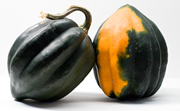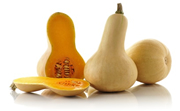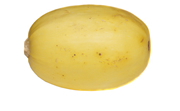Squash (Kürbis)
In Germany, the word Kürbis refers to both squash and a type of squash, the pumpkin.
Squash are fruits of the Cucurbitaceae family of plants. Often called a vegetable, squash, by botanical definition, is considered a fruit because it has its seeds on the inside.
Historically, squash was very popular in the German cuisine. Chefs and home cooks all knew hundreds of ways to prepare it. Gradually, the popularity of the pumpkin diminished ... until recently. For the past several years, squash has made a comeback and there is new enthusiasm for its versatility and health benefits.
Popular Squash Varieties in German Cooking
Acorn Squash (Eichelkürbis)

Photo: © Blank Line Studios - Fotolia.com
|
|
Winter Squash; Available year round.
Shaped like an acorn. Weighs from 1-3 pounds and has a sweet, slightly fibrous flesh. Dark green, golden, and multi-colored varieties. Great for baking.
Ambercup Squash (Hokkaido)

Photo: © IngridHS - Fotolia.com
|
|
Winter Squash; Available June to November.
Resembles a small pumpkin. Deep orange flesh with a sweet taste. Similar to the butternut squash, but drier. Very long shelf life.
Baby Summer Squash or Pattypan Squash (Pattissons)

Photo: © Picture Partners - Fotolia.com |
|
Summer Squash; Available year round but peak season is May through August.
Small, flat squash in yellow, green, and white varieties. Scalloped edges, thin skin, tender meat. Can be cooked in the microwave, on the stove, baked in the oven, or used cooked or raw as a garnish.
Butternut Squash (Butternuss-Kürbis)

Photo: © SunnyS - Fotolia.com
|
|
Winter Squash; Available year round but peak season is early Fall through Winter.
Beige to creamy-colored; bottle-neck shaped. Fine-textured, deep-orange flesh with a sweet, nutty flavor. Great baked or steamed.
Pumpkin (Speisekürbis, Gartenkürbis, or Kürbis)

Photo: © djama - Fotolia.com |
|
Winter Squash; Available year round but best in early Fall throughout Winter.
Drier, coarser, and more strongly flavored than most other squash. Yellow-orange, fibrous flesh.
Spaghetti Squash
(Spaghetti-Kürbis)

Photo: © dbvirago - Fotolia.com |
|
Winter Squash; Available year round but season runs early Fall through Winter.
Known for its flesh, which separates into long, blond, spaghetti-like strands as it cooks. Watermelon shaped. Mellow-tasting with a slight crispness. The more yellow the rind, the riper the squash. Spaghetti squash is cooked whole in boiling water (poke a few wholes in the rind before cooking). The strands are great for salads, casseroles or in place of spagetti pasta.
Zucchini

Photo: © Schlierner - Fotolia.com
|
|
Summer Squash; Available year round.
Mild flavored, which makes it very versatile: t can be eaten raw, grilled, fried, sautéed, baked, in salads, in pasta dishes, on sandwiches, and baked in bread and cake. Select zucchini with glossy, firm, dark green skin.
|

Photo: © bendicks - Fotolia.com

Squash is classified as either "winter squash" or "summer squash." However, these do not determine when they are available. Most varieties are available year round. The terms more accurately group the squash by durability.
Summer squash includes those varieties of squash that are (1) grown during any warm, frost-free season (typically Summer), and (2) harvested before the rind hardens and the fruit matures. This group includes zucchini and yellow squash. Summer squash is moister than winter squash due to higher water content.
Winter squash includes those varieties of squash that have hard, thick rinds that are not edible. Most varieties are vine-type plants whose fruits are harvested when fully matured. They take longer to mature than summer squash (3 or more months) and are harvested once the cool weather of Fall sets in. This group includes acorn squash, ambercup squash, pumpin, butternut squash, and spagetti squash.
|

Summer Squash
Summer squash are thin-skinned fruits that bruise easily. When selecting, look for firm, bruise free squash with taut skin. Usually the smaller ones are sweeter and more tender. Store them in the refrigerator for up to two weeks. Note that after about 1 week, they begin to soften and wrinkle.
Winter Squash
Winter squash have thick, hard rinds. Choose those that are firm and well-shaped, and are heavy for their size. Avoid any squash with sunken or moldy spots and cuts or punctures. Variations in color are fine - they do not affect the flavor. However, stick with those that have a tough, hard skin. A tender rind indicates it was picked too early, which makes a poor quality fruit. Store winter squash in a cool (between 45°F and 50°F), dry well-ventilated location. Use within three to six months.
|
|

